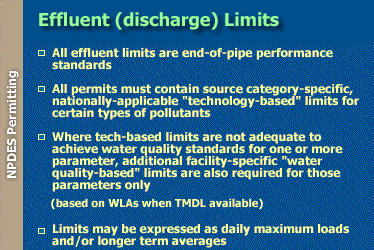Effluent Limits
Technology-based effluent limits do not specify what technologies must be employed, but only the state levels of specific parameters that are allowed in the discharger's wastewater. Such limits are called "performance standards."
Technology-based limits are derived from studies of facilities within a specific industrial category aimed at determining what levels of discharge, pollutant by pollutant, can be achieved using the most cost-effective set of available pollution prevention and control techniques applicable to those types of facilities. EPA publishes packages of regulations, called "effluent guidelines," which lay out performance standards for different types of facilities within major industrial categories. All dischargers within each of these subcategories are required to meet these end-of-pipe limits, regardless of the condition of the water into which they discharge, their contribution of a pollutant relative to other sources, or other "risk-based" factors.
For existing direct dischargers, effluent guidelines are referred to as best available technology economically achievable (BAT). For new sources, technology-based limits are called New Source Performance Standards. Limits for new sources are often more stringent than those for existing sources, because new facilities can employ more options for building pollution prevention systems into their in-plant processes.
(Note: EPA also includes in its effluent guidelines package for a specific industrial category technology-based limits for "indirect" dischargers. These are called "categorical pretreatment standards," and cover performance standards for both existing and new sources. (EPA's effluent guidelines web site)
Water Quality-Based Effluent Limits (WQBELs) are used when it has been determined that more stringent limits than technology-based effluent limits must be applied to a discharge in order to protect the designated use (DU) of the receiving waters. WQBELs are "back calculated" from ambient water quality standards, setting allowable pollutant levels in the effluent, which after accounting for available dilution, will meet WQS in-stream.
The permitting authority performs such calculations when a TMDL for the receiving water has not been established. When an EPA-approved TMDL is available, the effluent limits must be consistent with the wasteload allocation (WLA) assigned to the source by the TMDL.
When numeric water quality criteria are available, dilution calculations or more sophisticated mathematical models are used to determine corresponding loading rates. When only narrative standards are present, translator mechanisms can be employed. For instance, a translator for a "no toxics in toxics amount" narrative could be a limit on the overall toxicity of the discharge–a so-called Whole Effluent Toxicity (WET) limit.
WQBELs are risk based and therefore generally place much
less emphasis on economic and technological factors than do technology-based
limits.
The differences between technology-based and water quality-based approaches to setting limits on loadings of pollutants is illustrated here. "Waterbody" is put in parenthesis to make the point that under the technology-based approach, success is measured primarily by reductions in discharges of pollutants, not effects on receiving waters. Hence, ambient monitoring has often not been a high priority for states.
![[logo] US EPA](https://www.epa.gov/epafiles/images/logo_epaseal.gif)
